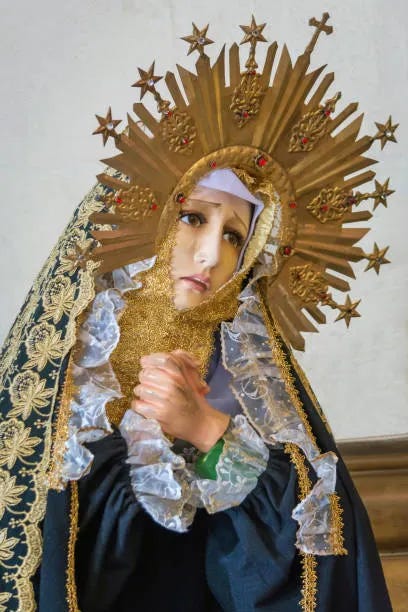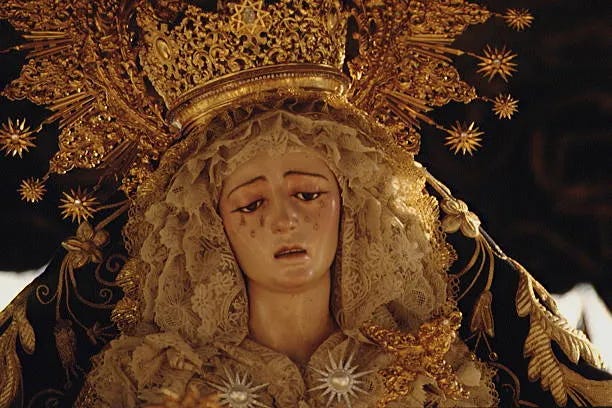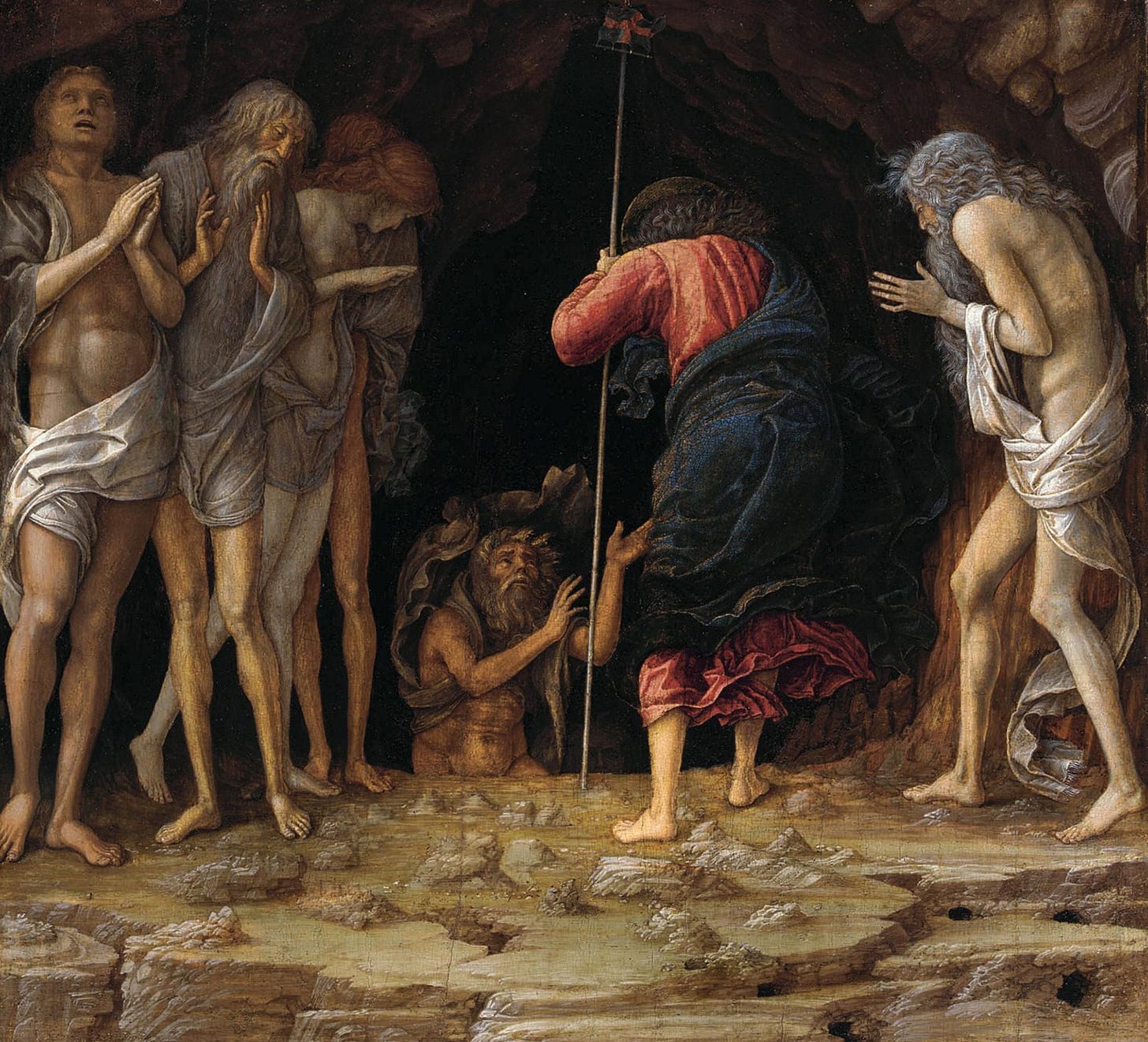We conclude our 9 day Novena to Our Lady of Sorrows which commenced on the Feast of Our Lady of Sorrows and concludes on Holy Saturday. We are praying for the following intentions:
The repose of the soul of the recently deceased, Fr. Paul Mangiafico
reparation for all blasphemies against Our Lord in the Blessed Sacrament
reparation for all blasphemies against the Blessed Virgin Mary
The Feast of the Seven Sorrows in September is devoted to all of her Seven Sorrows; the feast the Friday before Holy Week focuses more specifically the last four of those -- i.e., on what she suffered during Passiontide. In other words, the feeling of the day is akin to what one feels when looking at Michelangelo's Pieta: we imagine Our Lady watching her Son enduring His betrayal, His arrest, His torture, His crucifixion, His death, and His burial.1
Most Blessed and afflicted Virgin, Queen of Martyrs, who didst stand generously beneath the cross, beholding the agony of thy dying Son; by the sword of sorrow which then pierced thy soul, by the sufferings of thy sorrowful life, by the unutterable joy which now more than repays thee for them; look down with a mother’s pity and tenderness, as I kneel before thee to compassionate thy sorrows, and to lay my petition with childlike confidence in thy wounded heart. I beg of thee, O my Mother, to plead continually for me with thy Son, since He can refuse thee nothing, and through the merits of His most sacred Passion and Death, together with thy own sufferings at the foot of the cross, so to touch His Sacred Heart, that I may obtain my request,
Here pause and name the favours which you are asking Our Sorrowful Mother to obtain for you through this Novena. (Let your secondary intention be to pray for the intentions of all the people making this Novena})
For to whom shall I fly in my wants and miseries, if not to thee, O Mother of mercy, who, having so deeply drunk the chalice of thy Son, canst most pity us poor exiles, still doomed to sigh in this vale of tears? Offer to Jesus but one drop of His Precious Blood, but one pang of His adorable Heart; remind Him that thou art our life, our sweetness, and our hope, and thou wilt obtain what I ask, through Jesus Christ our Lord. Amen.
Hail Mary, Virgin Most Sorrowful, pray for us (seven times)






Giuseppe Sanmartino, 1753
Sanmartino’s Veiled Christ is one of the greatest sculptures of all time. Since the eighteenth century, travellers of all levels of distinction have come to contemplate this artistic miracle, to be disconcerted and enraptured by it. One of its innumerable admirers was Antonio Canova, who tried to buy it during his stay in Naples, and legend has it that he swore he would have given ten years of his life to have been the sculptor of this incomparable marble…
Matilde Serao wrote in great detail about the passion narrated by the features of the Christ, and Riccardo Muti chose the face of the Christ for the cover of his recording of the Mozart Requiem. The Argentine writer Hector Bianciotti spoke of his “Stendhal’s syndrome” at the sight of the marble veil, “folded, unfolded, reabsorbed into the cavities of an imprisoned voice, slight as gauze on the relief of the veins”. Recently, in an interview he gave for «Il Mattino», Adonis, one of the greatest contemporary poets, defined the Veiled Christ as “more beautiful than Michelangelo’s sculptures”.2
Today is a day of great silence. It's the “Ora della Madre” or "Hour of the Mother" as Our Lady -- and we -- mourn what has happened and await the resurrection of her Son.
Christ is in His tomb. Rather, His Body is in the tomb, but when His Soul left His Body, He descended into Hell to "free the captives." "Hell" here refers to the place of the dead in general ("Sheol" in the Hebrew, or "Hades" in the Greek), not to the place of torment with which the word "Hell" is most usually associated with today. The world "Hell" in the loosest, earliest sense includes:
the Limbo of the Fathers, the place for those who were righteous by charity and faith in the coming Messias and who died before His Coming
the Limbo of Infants, where, possibly, those who are sent who die without personal guilt but without Baptism after the time of Christ, or who died without charity and faith in the coming Messias before the time of Christ. This would be a place of beautiful, natural happiness, no punishment, and no sensible suffering.
Purgatory, where righteous people go to be cleansed of the temporal effects of their sins
Gehenna, the "Hell of the Lost," the eternal place of punishment for the damned, the place we usually refer to as simply "Hell" today
It was to the Limbo of the Fathers that Christ descended,1 a place of the dead that was emptied through His Passion, Resurrection and Ascension, and no longer exists. By this "Harrowing of Hell," as this Descent is called, the doors to Heaven were swung open so that those who die in a state of grace may enter in, alleluia! Adam, Eve, Noe, Abraham, Moses, the good thief on the cross -- all the righteous were illuminated by the Presence of Christ in the place of death, making Sheol itself a paradise. They remained there with Him until His Bodily Resurrection when the the "bars of Hell" were broken down and they were later able to enter into Heaven itself.
Today a great silence reigns on earth, a great silence and a great stillness. A great silence because the King is asleep. The earth trembled and is still because God has fallen asleep in the flesh and he has raised up all who have slept ever since the world began... ..He has gone to search for Adam, our first father, as for a lost sheep. Greatly desiring to visit those who live in darkness and in the shadow of death, he has gone to free from sorrow Adam in his bonds and Eve, captive with him -- He who is both their God and the son of Eve.. "I am your God, who for your sake have become your son... ...I order you, O sleeper, to awake. I did not create you to be a prisoner in hell. Rise from the dead, for I am the life of the dead."3
Holy Saturday
Morning Meditation
MARY HAS TO BID FAREWELL TO JESUS
In raising the stone to close up the entrance to the Tomb, the holy disciples of the Saviour had to approach the Blessed Mother and say: Now, O Lady, we must close the Sepulchre. Forgive us. Look once more on thy Son, and bid Him a last farewell. Then, my beloved Son--must the afflicted Mother have said--then shall I see Thee no more? Receive, therefore, on this last occasion that I behold Thee, my last farewell, the farewell of Thy dear Mother, and receive also my heart which I bury with Thee.
I.
When a mother is by the side of her suffering and dying child, she undoubtedly feels and suffers all his pains; but after he is actually dead, when, before the body is carried to the grave, the afflicted mother must bid her child a last farewell; then, indeed, the thought that she is to see him no more is a grief that exceeds all other griefs. Behold the last sword of Mary's sorrow. After witnessing the death of her Son on the Cross, and embracing for the last time His lifeless Body, this blessed Mother had to leave Him in the sepulchre, never more to enjoy His beloved presence on earth.
That we may better understand this last dolour, we will return to Calvary and consider the afflicted Mother, who still holds the lifeless Body of her Son clasped in her arms. O my Son, she seemed to say in the words of Job: My Son, thou art changed to be cruel towards me. (Job xxx. 21). Yes, for all Thy noble qualities, Thy beauty, grace, and virtues, Thy engaging manners, all the marks of special love Thou host bestowed upon me, the peculiar favours Thou hast granted me,--all are now changed into grief, and as so many arrows pierce my heart, and the more they have excited me to love Thee, so much the more cruelly do they now make me feel Thy loss. Ah, my own beloved Son, in losing Thee I have lost all. "O truly-begotten of God, Thou wast to me a father, a son, a spouse: Thou wast my very soul! Now I am deprived of my father, widowed of my spouse, a desolate, childless Mother; having lost my only Son, I have lost all." (St. Bernard).
Thus was Mary, with her Son locked in her arms, absorbed in grief. The holy disciples, fearful that the poor Mother might die of grief, approached her to take the Body of her Son from her arms to bear it away for burial. This they did with gentle and respectful violence, and having embalmed it, they wrapped it in a linen cloth which was already prepared.
The disciples then bore Jesus to the tomb. As the mournful train sets forth, choirs of Angels from Heaven accompanied it, the holy women followed, and with them the afflicted Mother also followed her Son to the place of burial. When they had reached the appointed place, O how willingly would Mary have there buried herself alive with her Son had such been His will. "I can truly say," Mary revealed to St. Bridget, "that at the burial of my Son one tomb contained, as it were, two hearts."
My afflicted Mother, I will not leave thee to weep alone; no, I will accompany thee with my tears. This grace I now ask of thee. Obtain that I may always bear in mind and always have a tender devotion towards the Passion of Jesus and thy sorrows, that the remainder of my days may thus be spent in weeping over thy sufferings, my own sweet Mother, and those of my Redeemer. These sorrows, I trust, will give me the confidence and strength that I shall require at the hour of death, that I may not despair at the sight of the many sins by which I have offended my Lord. They must obtain me pardon, perseverance, and Heaven, where I hope to rejoice with thee, and to sing the infinite mercies of my God for all eternity. Amen.
II.
Before leaving the Sepulchre, according to St. Bonaventure, Mary blessed the sacred stone which closed it, saying: "O happy stone, that doth now enclose that sacred Body which for nine months was contained in my womb. I bless thee and envy thee; I leave thee the guardian of my Son, of that Son Who is my whole Treasure and all my Love." Then, raising her heart to the Eternal Father, she said: "O Father, to Thee do I recommend Him--Him Who is Thy Son at the same time that He is mine." Thus bidding her last farewell to her beloved Jesus and to the Sepulchre, she left it, and returned to her own house. This Mother, says St. Bernard, went away so afflicted and sad, that she moved many to tears in spite of themselves; and wherever she passed, all who met her wept, and could not restrain their tears. And he adds that the holy disciples and women who accompanied her "mourned even more for her than for their Lord."
St. Bonaventure says that, passing, on her return before the Cross still wet with the Blood of her Jesus, she was the first to adore it. "O holy Cross," she then said, "I kiss thee, I adore thee; for thou art no longer an infamous gibbet, but a throne of love and an altar of mercy, consecrated by the Blood of the Divine Lamb, sacrificed on thee for the salvation of the world."
She then left the Cross, and returned home. When there, the afflicted Mother cast her eyes around, and no longer saw her Jesus; but, instead of the sweet presence of her dear Son, the remembrance of His beautiful life and cruel death presented itself before her eyes. She remembered how she had pressed that Son to her bosom in the stable of Bethlehem; the conversations she had held with Him during the many years they had dwelt in the house of Nazareth; she remembered their mutual affection, their loving looks, the words of Eternal Life which fell from those Divine lips; and then, the sad scene she had that day witnessed again presented itself before her. The nails, the thorns, the lacerated flesh of her Son, those deep Wounds, those uncovered bones, that open mouth, those dimmed eyes, all presented themselves before her. Ah, what a night of sorrow was that night for Mary! The afflicted Mother, turning to St. John, mournfully said: "Ah, John, tell me where is thy Master?" She then asked the Magdalene: "Daughter, tell me, where is thy Beloved? O God, who has taken Him from us?" Mary wept, and all who were present, wept with her.
And thou, my soul, weepest not! Ah, turn to Mary, and address her with St. Bonaventure: "O my own sweet Lady, let me weep; thou art innocent, I am guilty." Entreat her at least to let thee weep with her: "Grant that I may weep with thee." She weeps for love; do thou weep through sorrow for thy sins. I pity thee, my afflicted Mother, for the bitter sword which pierced thee on seeing thy Son in thy arms already dead, no longer fair and beautiful as thou didst receive Him in the stable at Bethlehem, but covered with Blood, livid and all lacerated with Wounds, so that even His bones were seen. Thou didst then say: "My Son, my Son, to what has love reduced Thee!" And when He was borne to the Sepulchre, thou wouldst thyself accompany Him, and place Him with thy own hands in the Tomb; and bidding Him the last farewell, thou didst leave thy loving heart buried with Him. By this Martyrdom of thy beautiful soul, do thou obtain for me, O Mother of fair love, the forgiveness of the offences I have committed against my beloved God, and of which I repent with my whole heart. Do thou defend me in temptations; do thou assist me at the moment of my death, that, saving my soul through the merits of Jesus and thee, I may one day, after this miserable exile, go to Paradise to sing the praises of Jesus and of thee for all eternity. Amen.4
Customs
In some parts of the world, like Southern Italy, the focus of the day, before the Vigil Mass that begins Easter, is Mary's desolation, and a special devotion -- Ora della Desolata -- involves great processions in which women veil themselves in black and sing in lamentation (in Latin American countries, this devotion is called El Pésame). See the page on processions for a most moving video of the Ora della Desolata as it is made in Puglia, Italy.
In some places, a ceremony is made of having a mock funeral for Lent after the Vigil Mass. In Poland, for example, a real or wooden herring is "mourned" and buried in a "good riddance!" gesture that acknowledges the end of Lent and the return of feasting!5
https://fisheaters.com/customslent10.html
https://www.museosansevero.it/en
https://fisheaters.com/customslent15.html
https://www.religiousbookshelf.com/meditations-and-readings/day/2156-Holy-Saturday.html
https://fisheaters.com/processions.html#ora







